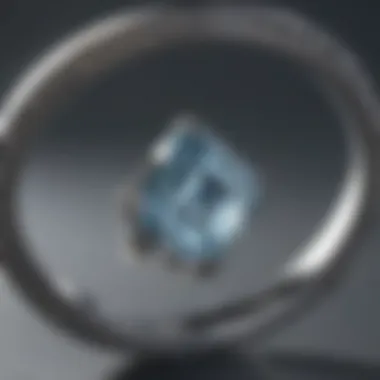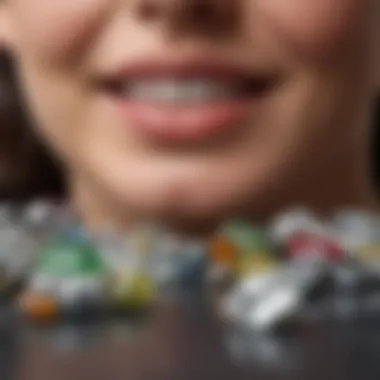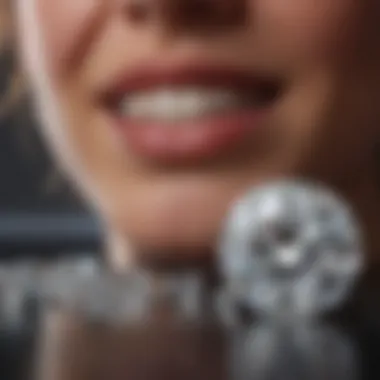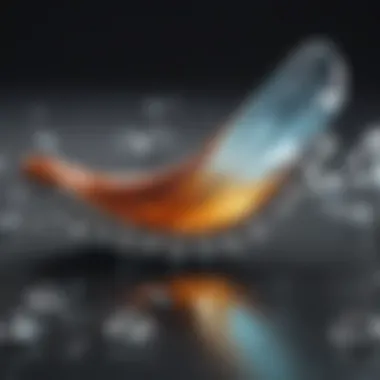Cleaning Diamonds with Toothpaste: A Unique Guide


Intro
The practice of cleaning diamonds often raises questions about the methods employed. Among these, using toothpaste as a cleaning agent stands out as an unconventional choice. This article aims to explore the effectiveness and safety of this method, evaluating the composition of toothpaste and how it compares to specialized diamond cleaners. We will inform gemstone enthusiasts, jewelers, and collectors about efficient cleaning practices to maintain the shine and brilliance of their diamonds.
Gemstone Overview
Definition and Characteristics
Diamonds are a form of carbon that has been subjected to extreme heat and pressure deep within the Earth. This process creates a solid crystal structure known for its extraordinary hardness and brilliance. The most valued characteristics of diamonds include their cut, clarity, color, and carat weight. These four characteristics, commonly referred to as the "Four Cs," play a significant role in determining the stone's value and appeal.
Classification of Gemstones
Gemstones can be classified into two primary categories: precious and semi-precious. Diamonds fall into the precious gemstone category alongside sapphires, rubies, and emeralds. Each of these gemstones possesses unique properties that contribute to their rarity and desirability. Diamonds are particularly favored due to their unrivaled hardness, often rated a 10 on the Mohs hardness scale.
The classification also extends to various types of diamond cuts which influence how light interacts with the stone. Popular cuts include round, princess, and emerald, each offering distinct aesthetic qualities.
While diamonds are known for their sturdy nature, they can gather dirt and oils from everyday wear, which may diminish their brilliance. This brings us back to the question of how to safely and effectively clean them.
Historical Significance
Ancient Uses and Cultural Importance
Throughout history, diamonds have been treasured across many cultures. In ancient India, they were believed to possess mystical properties, often associated with power and wealth. They were worn not only as adornments but also to ward off evil spirits. Similarly, in Europe during the Renaissance, diamonds were considered symbols of divine favor and protection.
Myths and Legends Surrounding Gemstones
Numerous myths surround diamonds, attributing them magical properties. For instance, some believed diamonds could bring luck or protect against betrayal. While these myths may not hold scientific merit, they contribute to the allure and cultural significance of diamonds.
Closure
In the quest for effective cleaning methods, understanding the properties of diamonds and the potential risks involved in using toothpaste is crucial. By examining its composition alongside specialized cleaners, we can draw informed conclusions that can guide both collectors and casual wearers in proper diamond care.
Preamble to Diamond Care
Understanding how to care for diamonds is crucial for preserving their natural beauty and longevity. Diamond care involves various practices that can significantly impact the appearance and condition of these precious stones. Proper care ensures that diamonds maintain their brilliance and remain sparkling over time.
For gemstone enthusiasts and collectors, knowing how to clean and store diamonds is vital. Diamonds can accumulate dirt, oils from skin, and even residues from products like lotions or perfumes. This build-up can dull their sparkle, making it essential to have an effective cleaning regimen.
In this article, we will explore different methods of cleaning diamonds, including the use of toothpaste. We will also assess the risks associated with unconventional cleaning agents. By the end, readers will gain insights into best practices for diamond care, informed choices about cleaning methods, and ways to enhance their jewelry’s allure over time.
Importance of Proper Cleaning
Proper cleaning of diamonds is more than just enhancing their visual appeal. It directly affects the integrity of the stone. Cleaning removes contaminants that may etch or scratch the surface if they are allowed to remain for too long. Regular cleaning helps to preserve the quality of the stone and can prevent damage to the metal settings that hold it. Moreover, a clean diamond reflects light more effectively, accentuating its brilliance.
Neglecting to clean diamonds regularly can lead to dull appearance and loss of luster. For collectors, this can diminish the value of their pieces. Therefore, recognizing the importance of maintaining proper cleanliness is vital for anyone who values their diamond jewelry.


Common Methods for Cleaning Diamonds
There are several conventional methods for cleaning diamonds. Each has its merits and limitations.
- Professional Cleaning: This involves taking diamonds to a jeweler, where they use ultrasonic cleaners. These specialized tools remove dirt and grime without risking damage to the stone.
- Soaking in Water and Soap: A simple mixture of warm water and gentle dish soap can work effectively. Soaking for a few minutes can loosen dirt, making it easier to wipe away.
- Using a Soft Brush: A soft-bristled toothbrush can effectively clean hard-to-reach areas. This method is particularly useful for pieces with intricate settings.
- DIY Solutions: Some choose to create their own cleaning solutions using safe household items.
While many jewelers and enthusiasts suggest these methods, it is essential to choose one that fits the specific needs of the diamond and the individual owner's preferences.
Understanding Toothpaste
To evaluate the practicality of using toothpaste as a cleaning agent for diamonds, it is essential to first comprehend the very substance we are considering. Toothpaste serves not only as a dental product but also embodies chemical and physical elements that could impact gemstones. The choice to utilize it goes beyond mere convenience; an understanding of its composition and various types allows one to make a reasoned decision when caring for diamonds.
Composition of Toothpaste
Toothpaste is a unique concoction, primarily designed for cleaning teeth and freshening breath. Most products consist of several key components, each serving its purpose. A typical toothpaste formula may include:
- Abrasives: These help remove plaque and stains without damaging teeth. Common abrasives are silica, calcium carbonate, and hydrated aluminum oxide.
- Fluoride: This ingredient is well-known for its role in fighting tooth decay. While fluoride is not relevant for diamond care, it is still significant in the overall composition.
- Humectants: Substances like glycerin and sorbitol keep the paste moist and prevent it from drying out in the tube.
- Surfactants: Often included to assist in foaming action, surfactants such as sodium lauryl sulfate can aid in delivering the paste’s cleaning properties.
- Flavoring agents: These make toothpaste palatable, commonly mint, but also can include fruit flavors.
The abrasiveness of the toothpaste, particularly, is the most important consideration when evaluating its safety for diamonds. Knowing the exact formula used can help assess whether it may cause scratches or dulling on the gemstone’s surface.
Types of Toothpaste Available
The market offers a variety of toothpaste options, each catering to specific needs. When discussing their suitability for cleaning diamonds, it helps to categorize them:
- Whitening Toothpastes: Often formulated with stronger abrasives, these may cause more wear to the diamond than regular formulations. The goal is to remove stains from teeth but might not be ideal for the delicate surface of diamonds.
- Sensitive Toothpastes: These are gentler and contain fewer abrasives. They might be safer for occasional use on diamonds but will still need caution.
- Natural Toothpastes: Typically do not contain certain chemicals but may include baking soda as a mild abrasive. They might present a safer alternative depending on the particular ingredients used.
- Gels vs. Pastes: The form of toothpaste can also matter. Gels generally contain fewer abrasives, while traditional pastes may provide more cleaning capability.
Your Diamonds: How They Can Get Dirty
Understanding how diamonds can become dirty is essential for their proper maintenance and care. Diamonds are often worn daily in rings, bracelets, and necklaces, making them susceptible to various contaminants and grime. Knowing the sources of dirt and understanding its effects is the first step in preserving a diamond's brilliance. Dirt not only alters the appearance of these precious stones but can also impact their setting and surrounding metal components. Thus, it is vital for jewelry owners to be well-informed about how their diamonds can accumulate dirt and how to effectively combat this issue.
Common Sources of Dirt and Grime
Diamonds can attract a variety of contaminants, which may diminish their sparkle. Here are some common sources of dirt and grime:
- Natural Oils: Skin secretes natural oils. When diamonds come into contact with skin, these oils transfer onto the stone.
- Cosmetics: Products like lotions, perfumes, and makeup can leave residues that stick to diamonds, clouding their clarity.
- Environmental Pollutants: Dust, smoke, and pollutant particles in the air can settle on diamonds when they're worn or stored improperly.
- Household Chemicals: Cleaning agents used around the home can unintentionally come into contact with diamonds, affecting their shine.
Being aware of these sources is crucial for diamond ownership and serves as a reminder to regularly check and clean your gemstones to maintain their aesthetic quality.
Effects of Dirt on Diamond Sparkle
The impact of dirt and grime on diamonds goes beyond mere appearance. When dirt accumulates, it can have significant effects:
- Diminished Brilliance: The light refraction through a clean diamond creates its signature sparkle. Dirt blocks light entry, causing a noticeable reduction in brilliance.
- Cloudy Appearance: Over time, accumulated dirt can make a diamond appear dull and lifeless, obscuring its natural beauty.
- Long-Term Damage: Prolonged exposure to certain substances can potentially scratch or weaken the diamond or its setting.
In practice, a dirty diamond often appears unattractive and uninspired. For gemstone enthusiasts and collectors, maintaining the clarity and sparkle of diamonds is paramount, emphasizing the need for consistent cleaning practices.
Evaluating Toothpaste as a Cleaning Agent


Understanding the role of toothpaste as a cleaning agent is vital for discerning diamond owners. This section explores its potential effectiveness and highlights the associated risks. Proper evaluation allows consumers to make informed decisions based on their diamond's condition and cleaning needs.
Effectiveness of Toothpaste on Diamonds
Toothpaste contains mild abrasives and cleaning agents which may contribute to cleaning diamonds, particularly those coated in light dirt, oil, or residue. The effectiveness largely depends on the specific formulation of the toothpaste. Whitening toothpaste or those labeled "tartar control" often possess stronger abrasives that might scratch softer materials. Thus, while toothpaste could work on basic grime, it may not be suitable for all types of diamonds or all levels of accumulated dirt.
A significant factor in utilizing toothpaste on diamonds is the concentration of its ingredients. The presence of baking soda or other similar components can enhance cleaning abilities. However, these substances must be approached with caution as their abrasive nature can impact the diamond’s finish over time. Results can vary, leading to mixed reviews among users. Some report satisfactory results while others observe dullness in their diamonds. It is essential to proceed with caution to maintain the stone's integrity.
Risks Involved with Toothpaste Usage
Using toothpaste for diamond cleaning is not without its hazards. There are several risks such as:
- Scratching: Toothpaste can scratch the diamond surface, especially if it contains hard or harsh abrasives.
- Residue: After cleaning, some toothpaste might leave behind a film, leading to a dull appearance rather than a sparkling one.
- Chemical Reactions: Some varieties contain additives like whitening agents, which could react adversely with the diamond's setting, particularly if it is made of softer metal like gold.
"While toothpaste might seem like an easy solution, understanding its impact on diamonds is key to preserving their beauty."
Methodology: How to Clean Diamonds with Toothpaste
Understanding the methodology for cleaning diamonds with toothpaste is crucial for anyone who wants to maintain the brilliance of their gems. Diamonds can accumulate dirt and oils over time, which dulls their shine. While there are various methods for cleaning them, using toothpaste is an option that many might not consider. This section will break down each step in detail, ensuring clarity and accessibility for gemstone enthusiasts.
Cleaning diamonds with toothpaste involves specific techniques that can make this home remedy effective when done correctly. Not only does it provide a straightforward approach, but it also allows diamond owners to take care of their jewelry without needing to visit a professional cleaner. However, caution is critical, as mistakes can lead to damage. This methodology will clarify the process and highlight any important considerations.
Step-by-Step Instructions
To clean your diamonds using toothpaste, follow these steps:
- Select the Right Paste: Choose a white, non-gel toothpaste without any added whitening agents or abrasives.
- Prepare Your Materials: Gather your toothpaste, a soft toothbrush, and a bowl of lukewarm water.
- Apply Toothpaste: Place a small amount of toothpaste onto the toothbrush.
- Gently Scrub: Lightly brush the diamond in circular motions. Focus on the areas where grime is visibly accumulated.
- Rinse Thoroughly: After scrubbing, rinse the diamond under lukewarm water to remove all traces of toothpaste.
- Dry with a Soft Cloth: Pat the diamond dry using a clean, soft cloth to avoid scratching the surface.
Tools Required for the Process
Using the correct tools is essential for achieving optimal results when cleaning diamonds with toothpaste. Here’s what you will need:
- Non-gel Toothpaste: A basic white paste
- Soft Toothbrush: Ensure the bristles are not too hard to avoid scratching the diamond.
- Bowl of Lukewarm Water: This is for rinsing the diamond post-cleaning.
- Soft Cloth: A lint-free cloth works best for drying without leaving residue.
Remember, ensuring all tools are clean and ready will support the effectiveness of the cleaning process and protect your diamond from unnecessary scratches or damage.
Comparison with Specialized Diamond Cleaners
The discussion of comparing toothpaste with specialized diamond cleaners is crucial to understanding effective methods for maintaining diamonds. With many products available on the market, it can be overwhelming for diamond owners to determine the best options. Specialized cleaners are formulated specifically for diamonds, considering their delicate structure and unique brilliance. In contrast, toothpaste is a common household item often suggested for cleaning various surfaces. However, the effectiveness and safety of each method should be evaluated carefully.
Overview of Commercial Cleaners
Commercial cleaners for diamonds typically contain solutions aimed at removing dirt and oils without causing damage. Products like Connoisseurs Diamond Dazzle Stik or Hagerty Silver Foam offer specialized formulations that cater to the various needs of jewelry. Many of these cleaners come with user instructions that ensure safe application.
Benefits of commercial cleaners include:


- Targeted Formulation: These cleaners are created specifically for gemstones, guaranteeing a more thorough cleaning process.
- Ease of Use: Most commercial cleaners come with applicators or brushes: simplifying the cleaning process for users.
- Safety Assurance: Results from rigorous testing mean they are considered safe for use on diamond jewelry without the risk of scratches or damage.
Pros and Cons of Different Options
When weighing toothpaste against specially designed cleaners, several factors should be considered.
Pros of Toothpaste:
- Availability and Cost: Toothpaste is usually found in any household and is generally less expensive than specialized options.
- Mild Abrasives: Some toothpaste brands contain gentle abrasives that can effectively remove buildup.
- DIY Option: Users can control the cleaning process by choosing the amount and applying it as needed.
Cons of Toothpaste:
- Potential for Abrasiveness: Some toothpaste formulations may be too abrasive, risking scratches on the surface of diamonds.
- Chemical Ingredients: Certain additives in toothpaste could lead to longer-term damage or dull the sparkle of the gemstone.
- Not Tailored for Gemstones: Unlike commercial cleaners, toothpaste is not designed specifically for delicate jewelry, leading to subpar cleaning results.
Best Practices for Diamond Care
Maintaining diamonds requires a careful approach to ensure their brilliance and integrity over time. Best practices for diamond care significantly influence the longevity and beauty of these precious gemstones. Understanding how to preserve their quality through cleaning and storage can effectively prevent losses in value and appearance.
Regular care of diamonds not only involves cleaning but also proper handling and storage practices. The practices outlined below will guide owners in protecting their diamonds from potential damage while keeping them visually stunning.
Frequency of Cleaning
The frequency of cleaning your diamonds depends on several factors. One of the primary considerations should be the level of wear and exposure to dirt and oils from everyday activities. If diamonds are frequently worn, such as engagement rings, cleaning them every one to two weeks can help. This routine prevents dirt from accumulating and maintains their sparkle.
However, for items worn less often, such as pendant necklaces or earrings, cleaning can occur monthly or quarterly. It's essential to monitor how dirty they get. If you notice diminished brilliance, it is time for cleaning.
Regularly inspecting your diamonds helps in identifying any signs of dirt or grime that could impair their clarity. Signs may include a dull appearance or change in shine. Being proactive about cleaning and recognizing when it is needed will prolong the life of your gemstones and keep them sparkling.
Storage Tips to Maintain Quality
How and where diamonds are stored is crucial in preserving their quality. Proper storage protects diamonds from scratches, environmental damage, and loss. Here are best practices:
- Use Soft Pouches or Boxes: Always store your diamonds in soft fabric pouches or boxes designed for jewelry. This prevents them from coming into contact with harder surfaces that could cause scratches.
- Separate from Other Jewelry: Store diamonds separately from other jewelry items. This practice is crucial as even the hardest diamonds can scratch other softer gemstones. Additionally, diamond jewelry should never be stacked without protection.
- Keep Away from Direct Sunlight: Avoid placing diamonds in direct sunlight. Prolonged exposure can potentially alter their color over time, especially for colored diamonds.
- Humidity Control: Store diamonds in a dry environment. Excess humidity can promote tarnishing of the metal settings. Climate-controlled environments are ideal for maintaining quality.
- Routine Checks: Regularly check your diamond storage for any signs of wear and tear. This ensures you can catch any issues with settings or integrity early.
By adhering to these best practices, diamond owners can significantly enhance their gemstones' chance of long-term beauty and value.
Closure: Is Toothpaste a Viable Option?
The question of whether toothpaste is a suitable cleaning agent for diamonds is essential for jewelry owners and enthusiasts. The popularity of this unconventional method arises from the notion that it is an accessible and cost-effective alternative to specialized cleaners. This conclusion synthesizes the crucial elements discussed throughout this article, emphasizing the practicalities of using toothpaste and its implications for diamond care.
Summarizing Key Findings
In reviewing the effectiveness of toothpaste in cleaning diamonds, several key findings emerge:
- Cleaning Efficacy: Toothpaste can effectively remove surface dirt and oils from diamonds without damaging the stone when used correctly. However, the actual effectiveness largely depends on the formulation of the toothpaste.
- Risks Identified: There are considerable risks to consider, including the potential for abrasiveness. Some toothpastes contain micro-abrasives that can scratch the diamond's surface or damage its setting.
- Comparison to Specialized Cleaners: While toothpaste may serve as a temporary solution, dedicated diamond cleaners generally offer more reliability and safety. They often contain specific ingredients designed to gently cleanse precious gemstones without harsh effects.
"Using toothpaste to clean diamonds may be tempting, but understanding its implications is vital for maintaining gemstone integrity."
Recommendations for Diamond Owners
Based on the findings, several recommendations can be made for diamond owners:
- Limit Toothpaste Use: If opting to use toothpaste, do so sparingly and avoid any formulas with whitening agents or microbeads.
- Decide Based on Value: For high-value pieces, prioritize specialized diamond cleaners or professional cleaning services to ensure safety and effectiveness.
- Regular Maintenance: Establish a regular cleaning routine with safe products. Emphasize using proper storage methods and frequency of cleaning to maintain diamond brilliance.
- Educate Yourself: Read ingredient labels and research which products are safe for diamonds. Increasing knowledge will lead to better care decisions.







